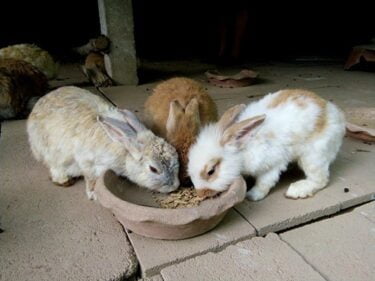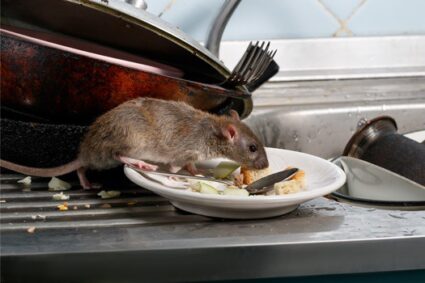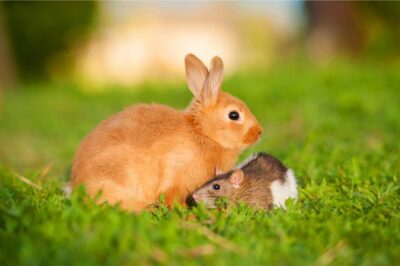Contrary to popular belief, rabbits are not rodents. The Rodentia (rodent) is the largest group of mammals, with 1500 of them being rodents (out of 4000 mammals). Rabbits were originally classified as rodents, but are now part of the order, Lagomorpha.
Rabbits and rodents are placental mammals that have short breeding cycles. They also give birth to multiple live young. However, after 1912, rabbits were no longer classified rodents. They are lagomorphs.
Many factors distinguish rabbits and rodents. The primary difference is that rabbits have an extra pair of incisors. They also differ in a few skeletal features. There about 87 existing species of lagomorph, including 28 species of rabbit and cottontail, 30 species of the hare and 29 species of pika.
Are Rabbits Rodents?
Rabbits and hares belong to the family, Leporidae, which is one of the two families in the order Lagomorpha. The other family is the Ochotonidae, also called the pika family.
Rodentia is the largest group of mammals that includes mice, rats, guinea pigs, hamsters, prairie dogs, chipmunks, squirrels, muskrats, beavers, chinchillas, and many others. Despite what was taught in our schools, rabbits do not belong to the order Rodentia.
Other mammals that are commonly mistaken for rodents include moles, hedgehogs, and shrew that belong to the order Eulipotyphla.
The reason rabbits were still considered as rodents in schools was that it took decades for textbooks to catch up with modern taxonomy. It took even longer for rabbits to be separated from rodents in popular culture.
Differences Between Rabbits and Rodents
Over 100 years ago, rabbits were still considered as rodents. In the early 20th century, paleontologists at the Smithsonian Institute began studying the differences between Rodentia and what was later to be called lagomorphs. In 1912, James W. Gidley proposed changing the classification of rabbits to lagomorphs.
The following are a few significant differences between rabbits and rodents.
Teeth
Rabbit and rodent teeth may appear similar, but they have many differences that set the two apart. In fact, the differences in their teeth are one of the major causes of the separation of rabbits from the Rodentia.
Rabbits have two sets of top incisors, whereas rodents only have one. Lagomorphs have their second pair of incisors in their upper jaw. These second incisors are tiny and tucked behind a larger set of main teeth. Therefore, they aren’t generally visible from the front.
Overall, rabbits have more teeth than rodents, though some of them can be quite small.
Furthermore, rabbit incisors are encased in enamel from both sides, whereas rodents have a layer of hard enamel only on the front. The back of the tooth in rodents is covered by a layer of dentine. In other mammals, the dentine is surrounded by enamel on all sides and lines the pulp cavity.
Having enamel only on the front, allows the teeth to be honed continuously against each other, resulting in sharp, chiseled shape. Rabbit teeth, on the other hand, never achieve a sharp end like that of rodents.
Unlike rodent incisors, rabbit incisors aren’t orange. This is because of the lack of iron salts.
Understanding Rodent Teeth
Rodents get their name from the order Rodentia. The word is derived from the Latin meaning “to gnaw” or “to chew.” Therefore, what makes rodents unique is their teeth. Biologists commonly sort animals into families and order via definition. Rodents are specialized chewers, hence their name.
Rodents have a single set of upper and lower incisors (front teeth), with varying numbers of premolars and molars (flat teeth at the back of the mouth). They also have gaps between these teeth called diastema. Plant matter is snipped off and passed through the diastema to the back teeth.
Although some rodents are omnivores and eat meat, they lack canine teeth. The outer surface of their incisors is lined with enamel, which ranges from orange-yellow to orange in color. Scientists believe that this coloring may be due to the addition of iron and minerals that strengthen the teeth.

The front of a rodent’s tooth is harder than the back, where a soft pulpy material called dentin coats the surface. Unlike human teeth, a rodent’s incisors continue to erupt and grow continually. This is called indeterminate growth. The same goes for rabbits. The tooth can perpetually grow because the incisors are rootless and open.
Since a rodent’s incisors grow continuously, its teeth must be worn down through chewing. Gnawing causes wear of the soft dentin in the back of the tooth, causing the harder enamel in the front to sharpen. Having sharp teeth is especially beneficial in chewing hard and fibrous plant matter and for protection.
Owners must provide their pet rodents and rabbits with something to chew on. When the incisors are not worn down, they can grow into the lower jaw, causing intense pain. This may also lead to oral or gastrointestinal issues. In some cases, this can become life-threatening.
Digestion
Although rodents and rabbits eat plant matter, rabbits are obligate herbivores. Rodents, on the other hand, can be omnivorous and may consume insects, grains, nuts, seeds, roots, tubers.
Rats are opportunistic feeders and may eat anything from fallen fruit to carcasses. The Norway rat, for example, often prefer foods high in protein, such as meat scraps or pet food.
Rabbits being obligate herbivores have a different digestive system to rodents. Rabbits break down foods similar to hooved animals. Cows, horses, and rabbits have a cecum in their guts. Some rodents also possess a large cecum, but they perform entirely different functions.
The cecum is Latin for “blind pouch,” which is found at the head of the large intestine. The cecum in rabbits carries an abundant supply of good bacteria that help break down and ferment cellulose, which is otherwise difficult to break down.
The main functions of the cecum in some rodents are to absorb salts and fluids that are left behind following intestinal digestion and absorption and to combine digested contents with mucus.
Coprophagy in Rabbits
When a rabbit consumes plant matter, it maximizes its digestion by eating its meal twice. In other words, rabbits eat their poop. Re-processing food the second time is called coprophagy.
Whatever a rabbit eats is passed down through its digestive tract and passed out in the form of a soft pellet, called a caecotroph. The caecotroph is then eaten, chewed, and re-digested to gain the maximum amount of nutrients. The resulting poop is a hard, round pellet, which we all recognize.
A few rodents, such as chinchillas and guinea pigs also possess a cecum and eat their own poop. However, this is the only known exception in rodents.
Reproduction
Rabbits and Lagomorphs do not have a baculum, but rodents do. Most mammals have a baculum or a penis bone that helps stiffen the male’s penis and allows the animal to mate for longer periods. Humans, whales, dolphins, marsupials, and horses don’t have baculum bones either.
The penis bone is an evolutionary adaptation that allows faster and longer matings. Hydraulics for animals without a baculum is much slower compared to inserting a bone structure into the genitalia and having a rapid erection.
Another advantage of quick erections is that it decreases the threat from predators. Instant erection allows these animals to spend less time in vulnerable and conspicuous mating positions.
Rodents vs. Rabbits Compared
| Rabbits | Rodents | Similarities |
|---|---|---|
| Lagomorphs | Rodentia | Cheek teeth look similar as both eat plant matter |
| Belong to the same group as hares and pikas | Same group as mice, rats, squirrels, guinea pigs, prairie dogs, porcupines, and hamsters. | Have large, chisel-shaped, ever-growing incisors |
| Incisors lined with a single of enamel | Incisors lined with enamel and dentine | Have an enlarged cecum to digest plant matter |
| Unpigmented incisors | Orange-yellow to orange incisors | Eat their own feces |
| Two pairs of upper incisors | One pair of upper incisors | Both eat plant matter |
| Strictly herbivorous | May eat animal matter | Placental mammals (have placenta during gestation) |
| Have high-crowned cheek teeth | Only some rodents have this feature | Have short breeding cycles |
| Maxillary fenestrations present | Maxillary fenestrations absent | Give birth to multiple live young |
| Baculum (penis bone) absent | Baculum present | Newborns feed on mother’s milk for nutrition |
| Short tails | Many have long tails | Both love to gnaw |
Are Rats Or Rabbits Smarter?
It’s hard to say whether rabbits or rats are smarter because both have their own unique set of abilities. Let’s take a closer look at the cognitive capacities of both.
Are Rodents Intelligent?
Rodents have impeccable cognitive abilities. Rodents can learn to avoid poisoned bait quite rapidly. This makes them difficult pests in many areas. Guinea pigs, for example, can learn and memorize complex pathways for food.
According to the University of Toronto and Princeton University, kangaroo rats and squirrels find catches using spatial memory, not just their sense of smell.
House mice and brown rats are extensively used in laboratory testing and are known to have advanced cognitive capacities.
Brown rats show a trait called cognitive bias. Information processing is influenced by whether the rat is in a positive or negative affective state. A PLoS One study indicates that lab rats that have been trained to respond to a specific tone to receive a reward are more likely to respond to an intermediate tone by selecting the reward lever if they have just been tickled.
Lab rats may also have the ability to acknowledge their own learning and make decisions according to what they know and don’t know. This is called metacognition, and they’re the only animals to share this ability with primates. Their choices are made by trading off tasks and expected rewards.
Are Wild and Domestic Rabbits Smart?
Rabbits are considered intelligent. Their sense of smell exceeds that of humans. They are capable of finding food as far as half a mile away from their nest. They can sprint faster and leap far above their ears.
Rabbits are remarkable engineers with the ability to dig complex tunnel networks. They’re also known for using roots of bushes and trees as structural supports.
Rabbits have been at the bottom of the food chain for quite some time. This means they have to be resourceful to survive in the wild. They climb as high as possible, keeping a lookout for predators. Rabbits have also adapted to become clever thieves, stealing grains from farms, especially during cold weather.
Rabbits can also use logic to solve problems. They can be taught tricks and are capable of learning a wide range of human words, making them perfect companion pets. They often learn through repetition, and with enough time and encouragement, they’re likely to discover patterns in vision and sound.
Some believe rabbits can count as well, at least in tiny amounts.

A rabbit’s intelligence is comparable to that of a cat or a dog. They know what they want and how to ask for it. Similar to cats, a rabbit will never consider you as their master and will do things in its own terms. Just like with cats and dogs, you can also converse with your pet rabbit. Learning your pet rabbit’s body language can help strengthen your bond.
Wild rabbits and domestic rabbits are intelligent in different ways. Because wild rabbits are at risk of being hunted the moment they’re born, they learn how to become cunning. Domesticated rabbits, on the other hand, appeal to human sensibilities more and can respond to human behaviors.
Some smart rabbit varieties include the Belgian Hare, the Harlequin Rabbit, and the Mini Lop.
Do Rats or Rabbits Breed Faster?
Rats and rabbits are some of the fastest-breeding mammals. The following explains the reproduction in both.
Reproduction in Rats
If conditions are suitable, the brown rat can breed throughout the year. A female rat can produce up to 5 litters per year, with each litter numbering up to 14 (however, 7 is common). Rats reach sexual maturity in just five weeks and have a gestation period of only 21 days.
Reproduction in Rabbits
Female rabbits become sexually mature at 3-8 months of age. They can conceive at any time of the year, at any point in their lives. A female rabbit can become pregnant within minutes after birth. However, sperm and egg production can decline after 3 years.
A female rabbit can have 1-14 kits per litter and potentially 60 kits per year. Hypothetically, a female rabbit can give birth to 12 litters per year, but the rabbit mating season is often in the springtime.
The gestation period in rabbits is short and can last anywhere around 28 to 36 days, with the average being 31 days. Shorter gestation periods lead to larger litters, whereas longer gestation periods yield smaller litters.


Is it possible to repel squirrels from a rabbit area with no fences? The squirrels kick the rabbits out of their home for their food. What do I do to keep the squirrels away? Maybe it is not possible;e. Thanks. Stam Peden, Aromas, CA